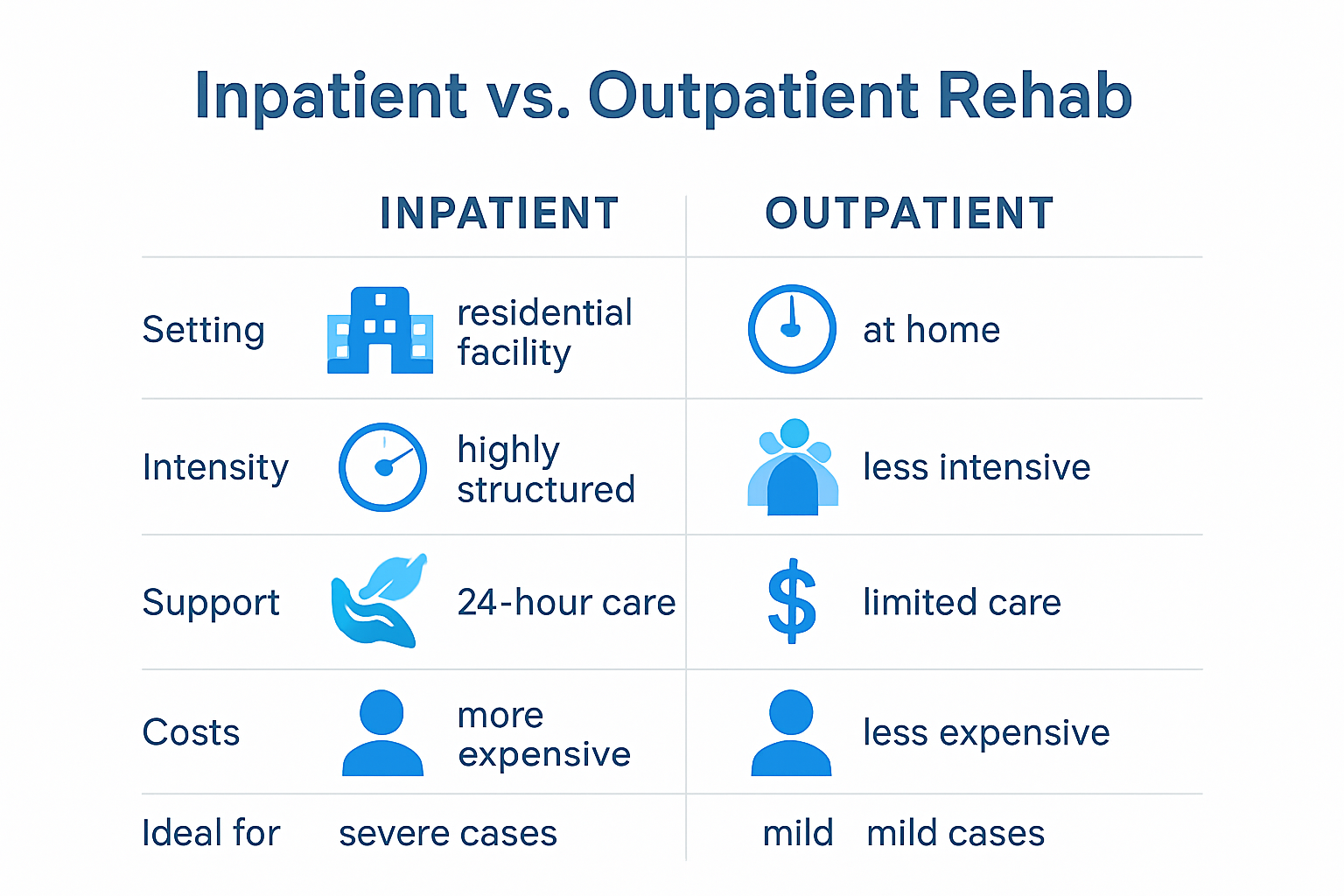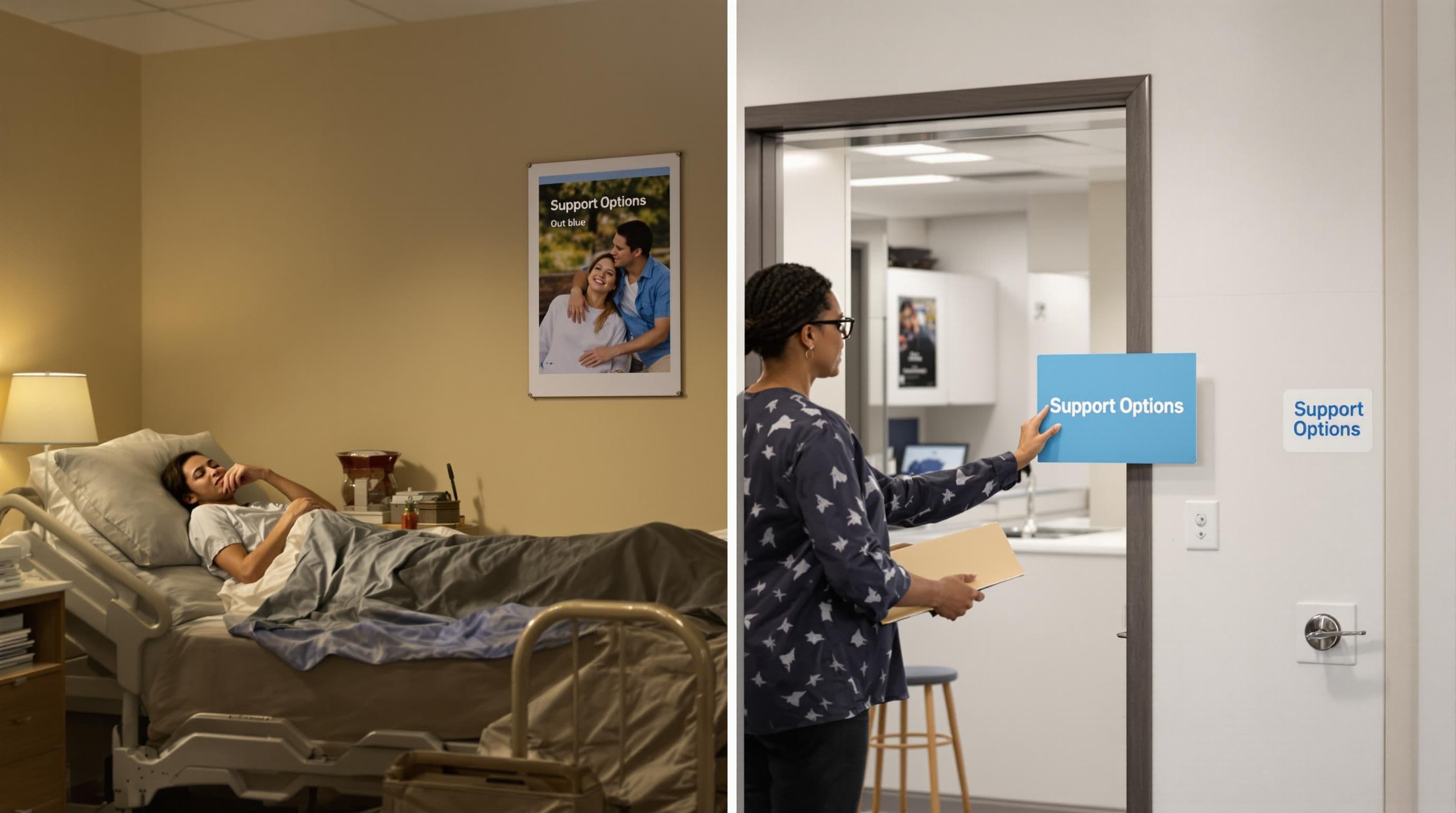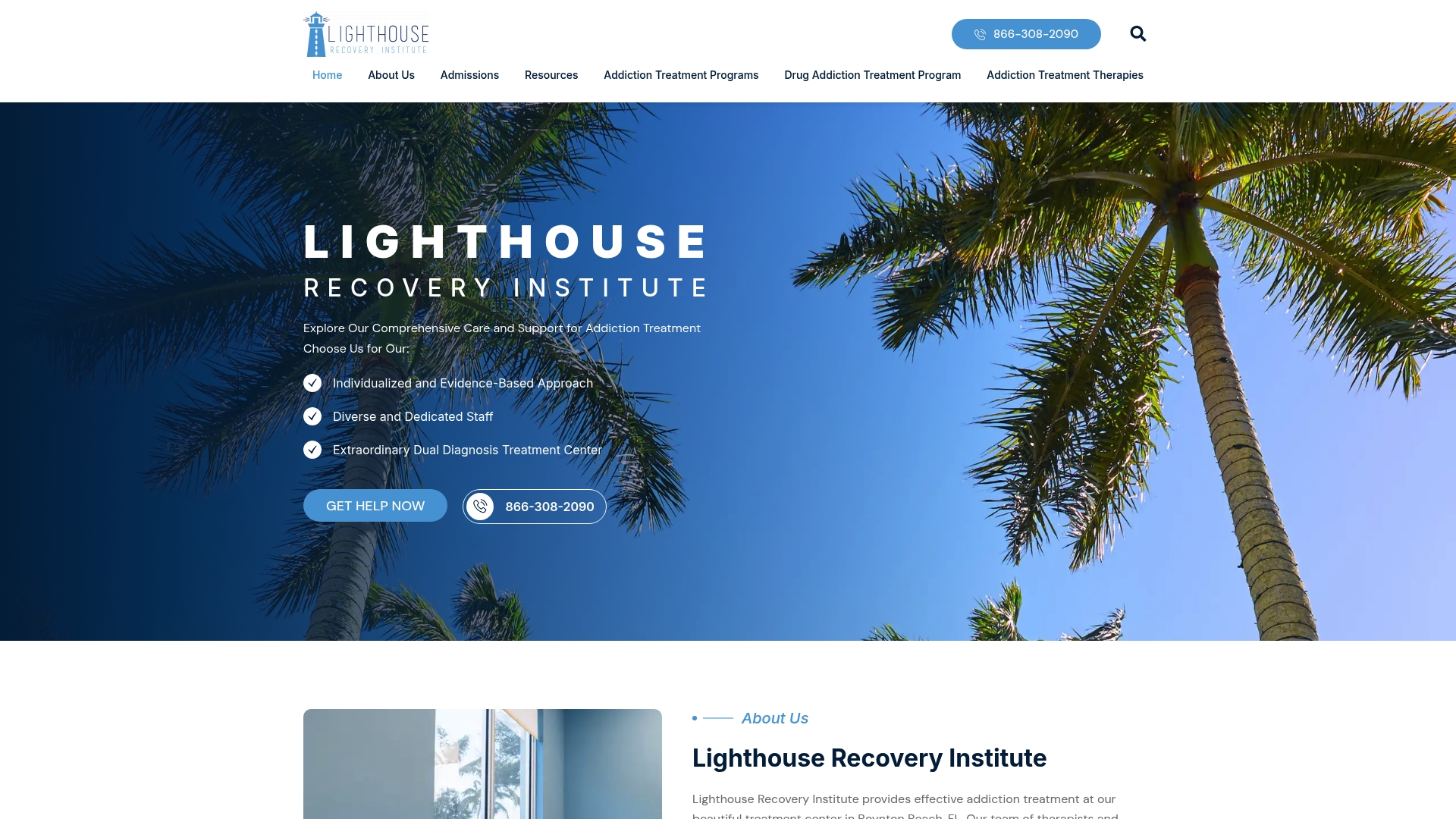Choosing between inpatient and outpatient rehab is one of the most important decisions anyone facing addiction will ever make. Most people assume it is just about picking whether you stay in a facility or commute from home. But take a look at this—the average cost for inpatient rehab can climb as high as $50,000, while outpatient options often run closer to $5,000 to $10,000. Suddenly, this is less about comfort and more about long-term recovery, finances, and support that can truly change lives.
Table of Contents
- Understanding Inpatient And Outpatient Rehab
- Key Differences Between Treatment Options
- Factors To Consider When Choosing Rehab
- Success Rates And Recovery Support Explained
Quick Summary
| Takeaway | Explanation |
|---|---|
| Inpatient rehab offers immersive support | Inpatient programs provide round-the-clock care, medical supervision, and structured environments, ideal for severe addiction cases. |
| Outpatient rehab provides flexibility | Patients in outpatient programs can maintain daily responsibilities while attending scheduled treatment sessions, suited for less severe addictions. |
| Costs differ significantly between options | Inpatient rehab typically costs $20,000 to $50,000, while outpatient services range from $5,000 to $10,000, impacting accessibility. |
| Consider personal readiness for treatment | Psychological and emotional readiness can determine the suitability of either inpatient or outpatient rehab, influencing treatment success rates. |
| Long-term results vary across treatment types | Although inpatient may show higher initial completion rates, outpatient improvements in recovery often depend on individual commitment and support systems. |
Understanding Inpatient and Outpatient Rehab
Addiction treatment is not a one-size-fits-all approach. Individuals struggling with substance use disorders have different needs, backgrounds, and recovery challenges that require tailored treatment strategies. Understanding the fundamental differences between inpatient and outpatient rehabilitation is crucial for anyone seeking effective addiction recovery.
Core Treatment Approaches
Substance Abuse and Mental Health Services Administration defines two primary rehabilitation models that address substance use disorders with distinct characteristics. Inpatient rehab provides a comprehensive, immersive treatment environment where patients reside full-time within a structured medical facility. This approach offers 24-hour professional supervision, intensive therapy, and a controlled setting designed to minimize external triggers and distractions.
Outpatient rehabilitation, in contrast, allows individuals to receive treatment while maintaining their daily responsibilities. Patients attend scheduled therapy sessions, counseling, and group meetings but return to their home environment after each treatment session. This model provides flexibility for those with work commitments, family responsibilities, or less severe addiction patterns.
Treatment Intensity and Structure
The primary distinction between inpatient and outpatient rehab lies in treatment intensity and structural support. National Institute on Drug Abuse research indicates that inpatient programs typically offer more comprehensive care for individuals with complex addiction histories. These programs include medical detoxification, individual and group therapy, psychiatric support, and holistic wellness interventions.
Outpatient programs, while less intensive, provide significant therapeutic interventions. They are particularly effective for individuals with strong support systems, stable living environments, and moderate substance use disorders. Participants receive targeted counseling, develop coping strategies, and engage in recovery-focused activities without completely disrupting their personal and professional lives.
Choosing between inpatient and outpatient rehabilitation depends on multiple factors including addiction severity, personal circumstances, mental health status, and individual recovery goals. Each approach offers unique benefits designed to support individuals in their journey toward sustainable recovery and wellness.
Here is a comparison table that summarizes the main differences between inpatient and outpatient rehab, including setting, intensity, cost, duration, and ideal candidates:
| Factor | Inpatient Rehab | Outpatient Rehab |
|---|---|---|
| Setting | Residential facility (live-in) | Live at home, attend scheduled sessions |
| Intensity | High: 24/7 supervision, structured | Moderate: part-time sessions |
| Treatment Duration | 30-90 days (varies by program) | Several weeks to months, flexible |
| Cost | $20,000 – $50,000 | $5,000 – $10,000 |
| Best for | Severe/long-term addiction, co-occurring disorders | Mild/moderate addiction, strong home support |
| Impact on Daily Life | Significant disruption (leave work, family) | Minimal disruption (maintain responsibilities) |
| Medical Supervision | Constant | As needed/periodic |
Key Differences Between Treatment Options
Choosing between inpatient and outpatient rehab requires a nuanced understanding of their distinct characteristics. The treatment approach dramatically impacts recovery success, making it crucial to comprehend the key differences that distinguish these rehabilitation models.
Treatment Setting and Environment
Healthcare Research reveals significant variations in treatment settings between inpatient and outpatient rehabilitation. Inpatient rehab provides a controlled, immersive environment where patients reside full-time within a specialized facility. This setting eliminates external triggers, offers constant medical supervision, and creates a structured healing atmosphere. Patients receive round-the-clock care, ensuring immediate support during challenging recovery moments.
Outpatient rehab, by contrast, allows individuals to maintain their existing living arrangements. Patients attend scheduled treatment sessions while continuing to engage with their regular work, family, and social environments. This approach demands greater personal accountability and requires a stable support system to complement the treatment process.
Treatment Intensity and Time Commitment
The intensity of treatment represents another critical differentiator. National Institute on Drug Abuse studies demonstrate that inpatient programs typically involve more comprehensive and time-intensive interventions. These programs often require a commitment of 30 to 90 days, providing extensive therapeutic services including medical detoxification, individual counseling, group therapy, psychiatric evaluation, and holistic wellness approaches.
Outpatient programs offer more flexible scheduling, usually involving 9-12 hours of treatment per week. These programs are segmented into different levels of intensity. Partial hospitalization programs provide more structured support, while standard outpatient services might involve just a few hours of weekly therapy. This flexibility allows participants to balance treatment with personal responsibilities, making it an attractive option for those with work or family commitments.
Treatment Costs and Insurance Considerations
Financial implications play a significant role in treatment selection. Inpatient rehab generally represents a more expensive option due to comprehensive services, residential accommodations, and intensive medical supervision. Most programs range from $20,000 to $50,000 for a full treatment cycle. Insurance coverage varies, with some plans offering partial or complete reimbursement for medically necessary treatments.
Outpatient rehabilitation typically proves more cost-effective, with expenses ranging from $5,000 to $10,000 depending on treatment duration and frequency. Many insurance plans provide more straightforward coverage for outpatient services, making them more accessible for individuals with financial constraints.
Ultimately, the choice between inpatient and outpatient rehab depends on individual circumstances, addiction severity, personal support systems, and specific recovery goals. A comprehensive assessment with addiction professionals can help determine the most appropriate treatment pathway for sustainable recovery.
The following table breaks down the cost, insurance considerations, and treatment intensity for both inpatient and outpatient rehab as described in this section:
| Aspect | Inpatient Rehab | Outpatient Rehab |
|---|---|---|
| Cost (range) | $20,000 – $50,000 | $5,000 – $10,000 |
| Insurance Coverage | Varies: may be partial/full | Often more accessible |
| Treatment Intensity | Comprehensive, 24/7 care | Flexible, part-time sessions |
| Residential Costs | Included | Not applicable |
Factors to Consider When Choosing Rehab
Selecting the most appropriate rehabilitation approach is a deeply personal decision that requires careful evaluation of multiple complex factors. The journey to recovery is unique for each individual, and understanding the nuanced considerations can significantly impact treatment success and long-term wellness.
Personal Addiction Characteristics
National Center for Biotechnology Information research emphasizes that individual addiction profiles play a critical role in determining the most effective treatment approach. Factors such as substance type, duration of addiction, historical relapse patterns, and physiological dependence levels are fundamental in making an informed rehabilitation choice.
Substance use disorders involving severe physical dependencies or multiple substance interactions often require more intensive inpatient interventions. Individuals with long-term chronic addiction histories, complex medical complications, or co-occurring mental health disorders typically benefit more from comprehensive residential treatment programs. Conversely, individuals with shorter addiction timelines, stable support systems, and less severe substance use patterns might find outpatient rehabilitation more suitable.
Personal and Professional Circumstances
Medical Research highlights that personal circumstances significantly influence rehabilitation choices. Work commitments, family responsibilities, financial constraints, and existing support networks are crucial determinants in selecting an appropriate treatment model.
Outpatient rehabilitation offers considerable flexibility for individuals who cannot completely disengage from professional or familial obligations. These programs allow participants to maintain employment, continue educational pursuits, and preserve critical personal relationships while receiving targeted therapeutic interventions. Inpatient programs, while more disruptive to daily life, provide a comprehensive, immersive environment that minimizes external triggers and offers round-the-clock professional support.
Psychological and Emotional Readiness
Psychological preparedness represents a critical yet often overlooked factor in rehabilitation success. Addiction Treatment Research indicates that an individual’s motivation, emotional stability, and commitment to change are paramount in determining treatment effectiveness.
Some individuals require the structured, controlled environment of inpatient rehabilitation to develop initial coping mechanisms and break entrenched behavioral patterns. Others might find the gradual, community-integrated approach of outpatient treatment more aligned with their psychological readiness and personal growth objectives. The key is honest self-assessment and potentially consulting addiction professionals who can provide personalized guidance.
Recovery is not a linear process, and no single approach guarantees success. The most effective rehabilitation strategy emerges from a holistic understanding of individual needs, comprehensive professional assessment, and a genuine commitment to personal transformation. Consulting with addiction specialists, conducting thorough medical evaluations, and maintaining open communication with treatment providers can help individuals make the most informed decision about their recovery journey.
Success Rates and Recovery Support Explained
Recovery from substance use disorders is a complex journey with nuanced outcomes that extend far beyond simple treatment completion. Understanding the success rates and comprehensive support mechanisms for both inpatient and outpatient rehabilitation provides critical insights into long-term recovery potential.
Treatment Completion and Initial Outcomes
Canadian Agency for Drugs and Technologies in Health research reveals compelling insights into treatment effectiveness. Inpatient rehabilitation demonstrates higher treatment completion rates, with patients more likely to remain engaged throughout the entire treatment program. The structured environment, constant medical supervision, and comprehensive support systems contribute significantly to this enhanced adherence.
Outpatient programs, while offering greater flexibility, typically experience lower treatment completion rates. However, this does not necessarily translate to reduced long-term recovery potential. The success of outpatient treatment heavily depends on individual motivation, personal support networks, and the ability to maintain treatment commitments while managing daily life responsibilities.
Long-Term Recovery Perspectives
Long-term recovery outcomes present a more nuanced picture. Substance Abuse Research indicates that for alcohol use disorders, initial treatment benefits can vary dramatically between inpatient and outpatient approaches. Interestingly, short-term studies often show comparable or even slightly better outcomes for outpatient treatments, while longer-term follow-ups frequently reveal the comprehensive benefits of inpatient rehabilitation.
For individuals with severe substance dependencies, inpatient programs provide a more controlled environment that addresses multiple aspects of addiction. These programs offer integrated medical, psychological, and social support that can significantly improve long-term recovery prospects. Outpatient treatments, while effective for many, may require more robust personal support systems and individual commitment to achieve similar outcomes.
Comprehensive Recovery Support
Recovery support extends far beyond initial treatment completion. Successful rehabilitation involves ongoing engagement, continuous personal development, and robust support mechanisms. Both inpatient and outpatient approaches emphasize the importance of aftercare programs, which may include individual counseling, support group participation, and strategies for managing potential relapse triggers.
The most effective recovery strategies are those that recognize addiction as a chronic condition requiring ongoing management. This approach involves personalized treatment plans, adaptive support mechanisms, and a holistic view of individual wellness. Whether through inpatient or outpatient rehabilitation, the ultimate goal remains consistent: empowering individuals to build sustainable, healthy lives free from substance dependence.
Statistically, success rates vary widely based on individual circumstances, substance type, and personal commitment. No single approach guarantees complete recovery, but comprehensive, personalized treatment significantly improves long-term outcomes. Individuals considering rehabilitation should approach their recovery journey with patience, openness to professional guidance, and a commitment to personal transformation.
Frequently Asked Questions
What is the difference between inpatient and outpatient rehab?
Inpatient rehab involves live-in treatment at a facility with 24/7 medical supervision, suitable for severe addiction cases. Outpatient rehab allows individuals to attend scheduled treatment sessions while living at home, making it more flexible for those with less severe addictions.
How much does inpatient rehab cost compared to outpatient rehab?
Inpatient rehab typically costs between $20,000 to $50,000 for a full treatment cycle, while outpatient rehab usually ranges from $5,000 to $10,000, making outpatient options more accessible for many individuals.
Which type of rehab is more effective for long-term recovery?
While inpatient rehab shows higher treatment completion rates initially, outpatient success greatly depends on individual motivation, support systems, and personal circumstances. Both types can lead to successful long-term recovery when matched to the right individual needs.
What factors should I consider when choosing between inpatient and outpatient rehab?
When deciding, consider factors such as the severity of the addiction, personal and professional responsibilities, support systems, psychological readiness, and financial constraints. A thorough assessment with addiction professionals can help determine the best fit.
Ready for the Right Rehab Solution? Your Recovery Journey Starts Here
Finding the balance between the immersive structure of inpatient rehab and the flexibility of outpatient treatment is a huge decision. This article highlights major challenges like choosing the right level of care, managing costs and insurance concerns, and feeling confident that you are making the best choice for your unique situation. At Lighthouse Recovery Institute, we understand that the journey toward recovery is personal. Our team is experienced in providing both residential and outpatient treatment, helping you move forward no matter what your needs are.
If you are searching for a compassionate team who respects you and meets you where you are, the next step is simple. Visit Lighthouse Recovery Institute to discover how our peaceful Boynton Beach location and personalized programs can guide you through each step of recovery. Do not wait to get help. Schedule a confidential consultation today and get honest answers to your questions about inpatient vs outpatient rehab and which option is right for you. Your healthier future can start now.












